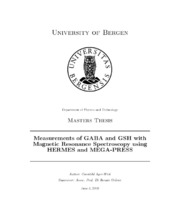Measurements of GABA and GSH with Magnetic Resonance Spectroscopy using HERMES and MEGA-PRESS
Master thesis
Permanent lenke
https://hdl.handle.net/1956/20464Utgivelsesdato
2019-06-27Metadata
Vis full innførselSamlinger
- Master theses [170]
Sammendrag
Magnetic resonance spectroscopy with the use of spectral editing, provides direct measurements of metabolites with low-concentrations, like GABA+ and GSH, in vivo in the human brain. The most common sequences used in spectral editing are HERMES and MEGA-PRESS, which are typically implemented as work-in-progress sequences at research sites and thus not standardized across vendors. Postdoctoral Fellow Muhammad Saleh and colleagues at the Johns Hopkins University School of Medicine, Baltimore, USA, therefore recently developed a universal editing sequence with common RF pulse shapes and timings for major MR vendors. As part of the collaboration with the group in Baltimore, GE and Siemens 3 Tesla systems at the Department of Radiology, Haukeland University Hospital, are used to test the universal HERMES and MEGA-PRESS sequences and compare to vendor provided (vendor-native) work-in-progress versions of HERMES and MEGA-PRESS respectively. This thesis aims to test the reproducibility of GABA+ and GSH using these editing techniques, to see if the values from HERMES and MEGA-PRESS correlate on either system, and investigate if the universal implementation is superior to the vendor specific implementations for measurements across vendors. As such, this thesis provides a summary of the current use of the vendor-native and universal-sequences and for the first time compares, vendor specific implementations with universal sequences in the field of GABA+ and GSH edited MRS. Areas were further optimization and standardization is needed are discussed. This project is part of the ongoing research in the Bergen fMRI group, University of Bergen/ Haukeland University Hospital. Magnetic resonance spectroscopy with the use of spectral editing, provides direct measurements of metabolites with low-concentrations, like GABA+ and GSH, in vivo in the human brain. The most common sequences used in spectral editing are HERMES and MEGA-PRESS, which are typically implemented as work-in-progress sequences at research sites and thus not standardized across vendors. Postdoctoral Fellow Muhammad Saleh and colleagues at the Johns Hopkins University School of Medicine, Baltimore, USA, therefore recently developed a universal editing sequence with common RF pulse shapes and timings for major MR vendors. As part of the collaboration with the group in Baltimore, GE and Siemens 3 Tesla systems at the Department of Radiology, Haukeland University Hospital, are used to test the universal HERMES and MEGA-PRESS sequences and compare to vendor provided (vendor-native) work-in-progress versions of HERMES and MEGA-PRESS respectively. This thesis aims to test the reproducibility of GABA+ and GSH using these editing techniques, to see if the values from HERMES and MEGA-PRESS correlate on either system, and investigate if the universal implementation is superior to the vendor specific implementations for measurements across vendors. As such, this thesis provides a summary of the current use of the vendor-native and universal-sequences and for the first time compares, vendor specific implementations with universal sequences in the field of GABA+ and GSH edited MRS. Areas were further optimization and standardization is needed are discussed. This project is part of the ongoing research in the Bergen fMRI group, University of Bergen/ Haukeland University Hospital.
